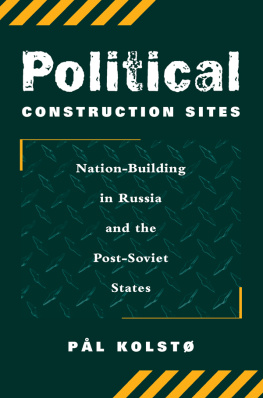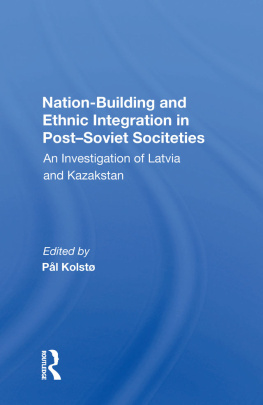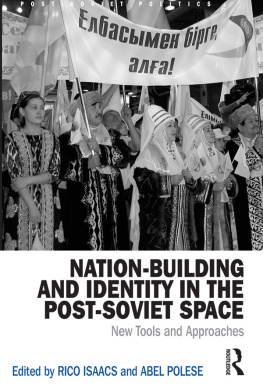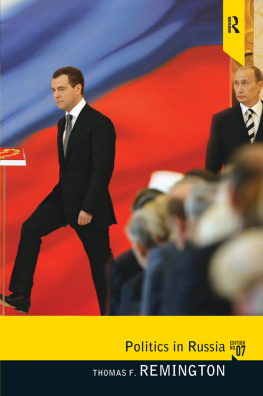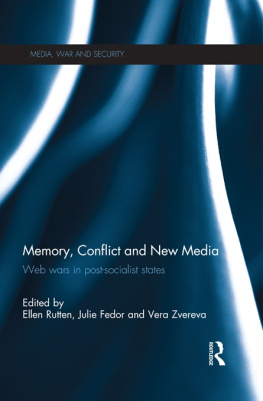Political Construction Sites
Maps drawn by Trond A. Svensson
First published 2000 by Westview Press
Published 2018 by Routledge
711 Third Avenue, New York, NY 10017, USA
2 Park Square, Milton Park, Abingdon, Oxon OX14 4RN
Routledge is an imprint of the Taylor & Francis Group, an informa business
Copyright 2000 Taylor & Francis
All rights reserved. No part of this book may be reprinted or reproduced or utilised in any form or by any electronic, mechanical, or other means, now known or hereafter invented, including photocopying and recording, or in any information storage or retrieval system, without permission in writing from the publishers.
Notice:
Product or corporate names may be trademarks or registered trademarks, and are used only for identification and explanation without intent to infringe.
Library of Congress Cataloging-in-Publication Data
Kolst, Pl.
Political construction sites : nation building in Russia and the Post-Soviet states /
Pl Kolst.
p. cm.
Includes bibliographical references and index.
ISBN 0-8133-3751-8 (he)ISBN 0-8133-3752-6 (pbk.)
1. Former Soviet republicsPolitics and government. 2. Nationalismformer Soviet
republics. 3. EthnicityFormer Soviet republics. I. Title: Nation building in Russia and
the post-Soviet states. II. Title.
JN6581 .K65 2000
320.947dc21 99-059717
ISBN 13: 978-0-8133-3752-4 (pbk)
This book is written for the undergraduate student as well as the general reader. Some chapters and parts of chapters are adapted versions of previously published articles and monographs. These are listed in the bibliography together with other sources; readers who want more detailed analysis than this book provides should consult these works.
This book is part of the research project Nation-Building and Ethnic Integration in Post-Soviet Societies, financed jointly by the Norwegian Research Council and the Norwegian University Council through the Program for Eastern Europe. Without their support I could not have written this book.
Bente Bergesen, Kristian Gerner, Hans Olav Melberg, Susan Hoivik, and the publishers anonymous reviewer read the manuscript of the whole book, and several colleagues contributed suggestions and corrections to one or more chapters: Aadne Aasland, Helge Blakkisrud, Tor Bukkvoll, Peter Duncan, Germ Jaanmat, Claus Neukirch, Yaacov Roi, and Sven Gunnar Simonsen. Their help allowed me to weed out some unfortunate mistakes and inaccuracies and induced me to add some additional perspectives.
Pl Kolst
Stavanger, Norway, June 1999
1
I NTRODUCTION
When the Soviet Union fell, fifteen new states saw the light of day. At first glance, this statement would appear quite unproblematic. But it cannot stand up to closer scrutiny. A state in the full sense of the word does not appear simply because of a political proclamation of independence or international recognition. A true state must have control of its own frontiers, have a monopoly of coercive powers on its own territory, be able to collect taxes and tolls, and so on. To carry out these and other necessary tasks, at least a modicum of administrative apparatus is required, as well as broad societal consensus as to the rules and routines for doing these jobs.
In winter 19911992 these preconditions were generally not fulfilled in any of the Soviet successor states of Eurasia. The armed forces on their territories were beyond the control of the new state authorities, as were the levers of economic policythe joint military command remained in Moscow, together with the state mint and banknote press. Administrations were understaffed, except in Russia, which could take over the old organs of the central Soviet powerso it ended up instead with an out-sized central administration. Furthermore, there were no border defense systems between the new states; indeed, state borders were not even marked on the ground.
For these reasons, it is better to say that during the winter of 19911992 the foundations were laid for the growth of fifteen new states in Eurasia. The establishment of governmental institutions and other attributes of the state is a long-term process that will continue for many years to come. Exactly what forms this process will take, and at what pace, will depend on a series of conditions: economic and geographical factors, the attitudes of other states (especially neighboring ones), the demographic and cultural composition of the population, and the political decisions taken by the eliteto mention only a few of the most important.
In this book, however, I leave aside the economic and institutional aspects and focus instead on some crucial political and cultural aspects of nation-building. If a state is to remain viable in the long term, it is essential that its people believe they have a common identity and a common destiny They must feel linked together by allegiance to certain shared values, as well as to the same shared symbols and institutions. This need not imply that everyone must feel culturally identical. There may well be pronounced regional differences, differences that can even find institutional expression by means of a federal state structure. But what is necessary is broad agreement as to the politicogeographical map of state legitimacy and the principles underlying its structure.
The USSR was officially defined as a multinational federation. By contrast, the successor states have proclaimed themselves national states or nation-statesand here a further difficulty arises. This concept, so basic to modern political science and related studies, can have several different meanings. Sometimes it is used simply to apply to all modern states, in contrast to the old dynastic states of the past. The modern state defines its field of responsibility and competence far more broadly than did states in former centuries. It is not enough merely to collect taxes and defend the land against internal and external foes: Todays state also has clear goals and strategiesfor improving the lives of its citizens (their standard of living, educational levels, and health conditions); for linking the country together through a tighter infrastructure; and so on.
The national (nation-) state can also be defined by contrast to the empire. An empire is usually understood as a heterogeneous state held together by external means of force, whereas the more homogeneous nation-state is seen as based on the consent of the populace. The empire has subjects; the nation-state has citizens. So what is the glue that holds the nation together? There exist at least two very different views as to what a nation is. Some use a political definition: The nation is simply the sum of all the citizens or inhabitants of that state. In this view the nation is kept together by its common territory, common government authority, and common political history. This has been the dominant understanding in the West and is enshrined, for example, in the name of the world organization: the United Nations.
There exists, however, a rival concept that sees the nation as a cultural entity, held together by common language, traditions, folklore, mores, and religionin short, the ethnic nation. This concept has deep roots in the eastern part of Europe, not least in Russia. One reason was that the multinational empires survived much longer in this part of the world. The state was imperial; the nation was nonstate. Central to the oppositional struggle against the empire was the notion of national autonomy, understood as the right of ethnic groups to organize states of their own.

